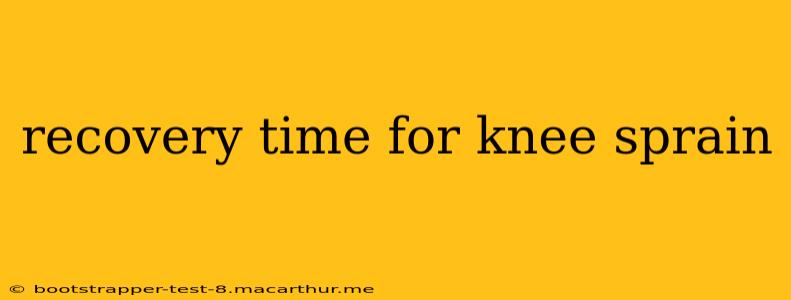A knee sprain occurs when the ligaments surrounding your knee joint are stretched or torn. The recovery time for a knee sprain varies greatly depending on the severity of the injury, the specific ligament(s) involved, and individual factors like age, overall health, and adherence to the treatment plan. This guide will delve into the specifics of knee sprain recovery, answering common questions and providing crucial information for a successful recovery.
What is the typical recovery time for a knee sprain?
The recovery time for a knee sprain can range from a few weeks to several months, even longer in severe cases. Mild sprains, involving only minor stretching of the ligaments, might heal within a few weeks with rest, ice, and compression. Moderate sprains, characterized by partial ligament tears, may require several weeks to months of rehabilitation. Severe sprains, involving complete ligament tears, often necessitate surgical intervention and a prolonged recovery period of several months, sometimes even a year or more.
How long does it take for a Grade 1 knee sprain to heal?
A Grade 1 knee sprain is a mild sprain with minimal ligament damage. Recovery typically takes 1 to 3 weeks, with symptoms improving gradually with rest, ice, compression, and elevation (RICE). Gentle range-of-motion exercises can be incorporated as pain allows.
How long does it take for a Grade 2 knee sprain to heal?
Grade 2 knee sprains involve a partial tear of the ligament, resulting in more significant pain, swelling, and instability. Recovery time for a Grade 2 sprain usually extends from 4 to 8 weeks. Physical therapy is often recommended to regain strength, stability, and range of motion.
How long does it take for a Grade 3 knee sprain to heal?
Grade 3 knee sprains represent a complete tear of the ligament, leading to severe pain, significant instability, and often requiring surgical repair. Recovery from a Grade 3 sprain can take several months, even a year or more, depending on the surgical procedure and the individual's rehabilitation progress. Intensive physical therapy is essential for a full recovery.
What factors affect knee sprain recovery time?
Several factors can influence the healing process:
- Severity of the sprain: As mentioned earlier, the grade of the sprain directly impacts recovery time.
- Age: Older individuals tend to heal more slowly than younger individuals.
- Overall health: Pre-existing conditions like diabetes or poor circulation can impede healing.
- Adherence to treatment: Following the prescribed treatment plan, including rest, physical therapy, and medication, is critical for optimal recovery.
- Complication development: Infections or other complications can prolong the healing process.
What are the signs of a knee sprain healing?
As your knee sprain heals, you'll likely notice a gradual decrease in pain and swelling. You'll also experience improved range of motion and increased stability in your knee. You'll be able to resume normal activities gradually without pain or instability. It's important to listen to your body and avoid pushing yourself too hard during recovery.
When should I see a doctor for a knee sprain?
You should seek medical attention if you experience:
- Severe pain
- Significant swelling
- Inability to bear weight on your leg
- Instability in your knee
- Deformity of the knee
- Persistent pain or swelling after a few days of home treatment
Early diagnosis and appropriate treatment are essential for optimal recovery from a knee sprain. A physician can accurately assess the severity of the injury and recommend the most effective treatment plan. This might include rest, ice, compression, elevation (RICE), pain medication, physical therapy, bracing, or in severe cases, surgery. Don't hesitate to seek professional medical advice to ensure a safe and effective recovery.
Disclaimer: This information is for educational purposes only and should not be considered medical advice. Always consult with a healthcare professional for diagnosis and treatment of any medical condition.
